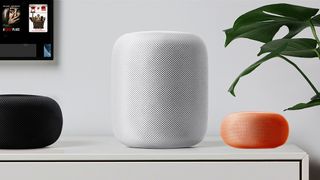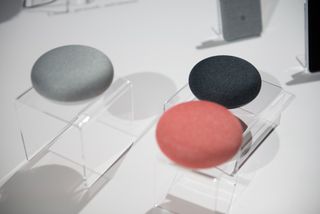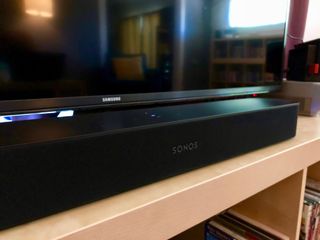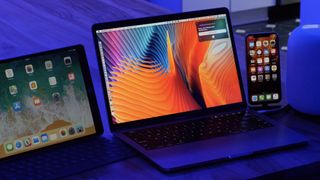How Apple could fix HomePod in 2019

Apple brought an expensive speaker to a commodity assistant war. That was pretty much the narrative around HomePod in 2018. It nailed the computational audio model and AirPlay 2, when that part finally arrived, but a lot of people were too busy throwing cheap, ok-enough sounding, but super smart Amazon or Google boxes into damn near every room in their house to notice.
But now Apple has John Giannandrea, Google's former head of Machine Intelligence and Search, on their executive team, and things could finally — huge emphasis on the could and finally — be getting much better for Siri.
What could all that mean for HomePod 2?
It's better to watch than to read! Hit play on the video above and subscribe for more!
HomePod Year One
Apple TV, iPhone, iPad, Apple Watch… all of them were fascinating, often game-changing new products with terrific new user experiences but fairly tragic limitation that prevented them from being truly transformative until at least the second generation.
That's when Apple TV switched from Lobot macOS to a variant of iOS, iPhone got 3G, GPS, and apps, iPad got lighter, faster, and multitasking, and Apple Watch began to focus on fitness.
Because of Apple's long pre-release development cycles, the first versions get massive amounts of attention but don't often hit the target, not exactly. But because of their quick iteration cycles, engineering can get it closer fast, and marketing… well, marketing can often redraw the targets.
Master your iPhone in minutes
iMore offers spot-on advice and guidance from our team of experts, with decades of Apple device experience to lean on. Learn more with iMore!
Apple began working on what became HomePod a good half-a-decade ago, long before the rise of products like Amazon Echo and Google Home. Back then, the goal really was to make a speaker you could put anywhere and that would sound great no matter where you put it or where you stood relative to it. And, because it would be a speaker and not have a screen, Siri was just the way you'd control it.
Apple got pretty close with the first part: It's a stunningly legit goram computational audio miracle how good the thing sounds as you walk around the room.
But, by the time it was released, were were fully into the age of low cost, commoditized Alexas and Assistants, and almost no one ended up caring about how good HomePod sounded — only how much it cost and how well and fully Siri worked on the shelf.
There are a few ways I think Apple could start turning all this around in Year Two.
HomePod mini
Apple never competed with netbooks. Instead, they shipped the MacBook Air and iPad. In the same way, I don't expect Apple to compete directly with commodity home hubs that are largely subsidized by massive data harvesting and exploitation, or as loss-leaders for equally massive online stores.

But, Apple does do mini.
Mac mini, iPod mini, iPad mini… HomePod mini.
Not everyone wants or needs a room-filling speaker. For some, a smaller speaker for the kitchen, bedroom, or to travel with and take in the camper or to the hotel room, would be ideal. Even and especially in a kid's room where, frankly, you'd have to be out of your mind to put a competing smart device based simply on recent data violations alone.
It still wouldn't be a $50 Amazon Echo competitor — Apple wouldn't do cheap speakers any more than it would do cheap netbooks — but it would be a smaller speaker for those who want to fill smaller rooms and nooks, and it would come with smaller price tag to match as well.
And, if past is prologue in any way, a range of funner colors that Apple seems to shy away from on the flagships.
Of course, Apple could also follow its tradition of simply introducing a new current-sized HomePod and dropping the price of the original by $100 or more to slot it in underneath, or repackage it as an iPhone 5c or Apple Watch Series 1 variant to accomplish the same thing.
But I like the idea of a HomePod mini as well. Again, like iPhone SE and iPad mini, it's not just about a lower price, it's also about a smaller profile.
Bluetooth Audio
I kind of get why Apple didn't include Bluetooth on the original HomePod. Again, they were bringing a speaker to an assistant war and if they had any chance of winning it was with audio quality. If all reviewers did was post endless head-to-heads with Bluetooth as the universally crappy conduit, a lot of HomePods audio advantage could have gotten compressed away.
But it's year two now. Everyone who cares about how good HomePod sounds knows about how good HomePod sounds, so it's time to let compatibility become key.
Just like Apple Music on Android and Alexa, putting BlueTooth on HomePod makes it more valuable to multi-platform, multi-device families. And increasing value is how Apple usually justifies higher prices.
(I'd add something about line in here but it's pretty clear Apple and almost everyone else is busy burying 3.5mm jacks, so… yeah.)
HomeBar
I used to use a fancy Dolby 7.1 system, but the moment it fell out of warranty, it began blocking all content with false HDCP flags. Total loss. So, vowing to never fall prey to that again, I went all in on a SONOS home theater system. Just one little optical cable from TV to the soundbar, mesh to the sub and surround Play:3, and all my TV filled my room.

I hoped HomePod could replace even the need for that one optical cable and those four separate speakers, provide room-filling, computationally mapped sound all on its own. Or, better still, two HomePods as a matched pair to really fill up the room.
And it does… kinda. For brief periods of time. Over AirPlay 2. But that's it. That's all. There's still no way to pair them with Apple TV like you would AirPods with iPhone and, once paired, have them go into TV priority mode and just work for all your home theater needs.
Devoting an entire HomePod to an Apple TV may not be the most flexible use of its capabilities, but it's what some segment of users wants to do and it would be great if Apple figured out a way to let HomePod and Apple TV make magic together.
At least unless and until Apple ships a full-on HomeBar theater system specifically for television. I mean, it's not like they're investing billions of dollars in original programming right now or anything.
Hey, a tech nerd can dream!
SiriKit for Media
SiriKit is Apple's application programming interface (API) for Siri. With it, third-party developers can integrate their apps and services so that Siri can control them. It's not an endless list of simple skills and it's not custom commands an automation like Siri Shortcuts, but a robust infrastructure that allows for variances.
At launch, HomeKit supported SiriKit extensions for messaging apps (like WhatsApp), to do apps (like OmniFocus or Things), and note-taking apps. But that's it.
Ride-sharing, payments, reservations, exist on iOS but haven't shown up yet on HomePod, not beyond Shortcuts. And they should. But audio extensions is what HomePod is really screaming for.
- Music apps, like Spotify and Google Music.
- Podcast apps, like Overcast and Pocket Casts.
- Spoken word apps, like Audible and Anchor.
Apple could always partner with services to bring then onto HomePod, but SiriKit would open it up to all services, new and small.
Mesh Siri
Right now, there's a different Siri for different devices, all with different capabilities. Siri on Apple TV is far more limited than iPhone or iPad, but has deep media knowledge and can even handle multi-language queries where, for example, a French speaker asks for a movie with an English title. Siri on Mac can interact with files and persist results but, frustratingly, can't control HomeKit.

Not being able to count on Siri to do something regardless of which device you ask to do it's bad for users. It creates uncertainty which chills usage.
Having all those Siri-capable devices could and should be a huge strength.
Apple devices can already quickly communicate with each other to determine which one should respond to "Hey Siri." They keep in contact using their own short-range network and "vote" on which device they think you're addressing.
Also, Apple Watch can already offer to send answers it's not capable of displaying on its own to your iPhone via Continuity.
What I'd really love is for all devices to be able to harnessing the capabilities of any other Siri device within range. In other words, surfacing the network as a mesh assistant voting not only on which device should answer, but which one is best capable of answering. In cases where those legitimately differ, Siri could even offer to send results to another device.
For example, HomePod: "I've found a list of movies playing nearby. Would you like me to read them to you or send them to your iPhone for you?" Then you could choose to browse and even take the results with you.
(Especially because, in a unified world, all devices would have some way to bookmark or pin Siri results the way Mac can.)
Some would argue Siri needs to live in the cloud and treat all devices as end-points but that has privacy and security implications beyond the scope of this video. Others, myself included, would argue that full on SiriOS would solve all of this and more. For now, if Siri is going to live on devices it needs to persist across those devices.
Speaking of mesh, it'd be great if all Apple's plugged-in devices worked for networking as well. HomePod, Apple TV, even the Mac and, hey, who knows, a next-generation router.
It would eliminate the need for a separate mesh networking system and let people have Apple, a privacy-first company, managing all the data leaving that network as well. Something some may not trust other, less privacy-centric companies to do.
4. Voice ID
Apple has been working on Voice ID for Siri for a long time. It shipped the first version with iPhone 6s and "Hey, Siri" and it's gotten better over time. HomePod, at least at launch, doesn't seem to have any Voice ID capability, and that greatly limits what it can do in a multi-user environment like the home.
Perhaps it's iOS' historic lack of multiple account support — only Apple TV offers even basic multiple account handling — or perhaps it simply isn't rock solid yet. Either way, it seems inevitable. The ability to use biometric voice prints to authenticate different family members opens up HomePod to being truly useful for everyone in the family.
That way, one roommate doesn't get another roommates messages, or parents don't get the favorites playlist filled with Raffi instead of Reggae.
(Though individual users will still have to decide if the contents of their messages, for example, from something as innocuous as planning a surprise party to as compromising as a liaison or illegal activities should really be read out loud at all, ever.)
Importantly, it would let Siri start to build up individual profiles for us. Right now, AI assistants aren't that intelligent. They can learn to better understand what we're saying when we ask for a Lyft but they don't really learn that we prefer Lyft to Uber. Likewise, they can start a connected shower for us when asked, but they don't really learn that we always want a shower started when we finish a workout. Deep context and prescience are next steps, not current tech.
But, to get there, Siri will need to safely, securely, privately start learning and understanding us far, far better. Siri Sync, which currently makes sure the training we do on one device carries over to the next, is a good framework to build on. And Apple's policy of tokenizing identify, encrypting traffic, and not leaving data around for commercial use, is reassuring.
But there's still a ton of work that needs to be done.
Siri Pad
Amazon, Google, and even Facebook — yeah, Facebook — offer versions of their home assistants with screens. The idea is that you place them in your kitchens to help you cook, your family rooms to help you communicate, and your bedrooms to… gross, no, do not put screens from those companies in your bedrooms. Not without draping a shirt or dozen over them or something.

Apple doesn't have a HomePod with a screen but, if you stick an iPhone or iPad on a stand, they essentially become HomePods with screens. They don't have the mic or speaker arrays, of course, but iPad especially can work as a HomeKit hub and all of them can handle voice commands.
But it'd be kind of cool if Apple offered a dock specifically designed to make iPhones or iPads more like HomePods. A dock with mic and speaker arrays. Not an iPod Hi-Fi, though that'd be kinda retro awesome, but something you plug into in the kitchen or family room, that can swivel to follow you around as you cook or clean to show you that recipe or keep you in that FaceTime frame, but that goes dead the minute you pluck your device off of it — fully charged, of course — so you can absolutely trust it not to be watching you when you don't want to be watched.
HomePod 2.0
There were 10 years of blackberry, palm, Nokia, and Windows Mobile before iPhone. A decade of Tablet PC before iPad. Apple released Watch much earlier, after only a few years of Pebble, but with HomePod, if anything, it just seemed like there was both less time to market and a way bigger chance Apple was late to the game.
But it only seems that way. The truth is, we're nowhere near the Palm, much less the Pebble stage of home assistants. If this was the Mac, we wouldn't even be past Xerox Park.
Until we have real JARVIS or FRIDAY or heck, KITT in Knight Rider level conversational AI interfaces, it remains anyone's game.
Apple has a ton of work to do but it they still have time to do it. All they need is the time, talent, and will to get it done.

Rene Ritchie is one of the most respected Apple analysts in the business, reaching a combined audience of over 40 million readers a month. His YouTube channel, Vector, has over 90 thousand subscribers and 14 million views and his podcasts, including Debug, have been downloaded over 20 million times. He also regularly co-hosts MacBreak Weekly for the TWiT network and co-hosted CES Live! and Talk Mobile. Based in Montreal, Rene is a former director of product marketing, web developer, and graphic designer. He's authored several books and appeared on numerous television and radio segments to discuss Apple and the technology industry. When not working, he likes to cook, grapple, and spend time with his friends and family.
Most Popular





